The Impact of Ho Addition on the Microstructural Features and Magnetic Performances of Sintered NdFeB Magnets
Abstract
1. Introduction
2. Materials and Methods
3. Results and Discussion
3.1. Magnetic Properties and Temperature Stability
3.2. Microstructure and Elemental Distribution
4. Conclusions
Author Contributions
Funding
Data Availability Statement
Conflicts of Interest
References
- Gutfleisch, O.; Willard, M.A.; Bruck, E.; Chen, C.H.; Sankar, S.G.; Liu, J.P. Magnetic materials and devices for the 21st century: Stronger, Lighter, and More Energy Efficient. Adv. Mater. 2011, 23, 821–842. [Google Scholar] [CrossRef] [PubMed]
- Sugimoto, S. Current status and recent topics of rare-earth permanent magnets. J. Phys. D Appl. Phys. 2011, 44, 110–118. [Google Scholar] [CrossRef]
- Deng, X.; Ge, J. Global wind power development leads to high demand for neodymium praseodymium (NdPr): A scenario analysis based on market and technology development from 2019 to 2040. J. Clean. Prod. 2020, 277, 123299. [Google Scholar] [CrossRef]
- Liu, T.; Li, R.Y.; Zhou, L.; Shi, X.N.; Wei, Z.Y.; Ren, M.; Guo, X.Y. Progress of coercivity enhancement in sintered NdFeB magnets. J. Chin. Soc. Rare Earths 2024, 1, 1. (In Chinese) [Google Scholar]
- Li, J.N.; Sepehri-Amin, H.; Sasaki, T.; Ohkubo, T.; Hono, K. Most frequent-ly asked questions about the coercivit y of Nd-Fe-B permanent magnets. Sci. Technol. Adv. Mater. 2021, 22, 386. [Google Scholar] [CrossRef] [PubMed]
- Satoshi, H.; Yutaka, M.; Hitoshi, Y.; Setsuo, F.; Masato, S.; Hiroshi, Y. Magnetization and magnetic anisotropy of R2Fe14B measured on single crystals. J. Appl. Phys. 1986, 59, 873. [Google Scholar]
- Nakamura, H.; Hirota, K.; Shimao, M. Magnetic properties of extremely small Nd-Fe-B sintered magnets. IEEE Trans. Magn. 2005, 41, 3844. [Google Scholar] [CrossRef]
- Zhu, X.D.; Wang, M.; Yu, Y.J.; Wang, Q.; Wang, F.; Wang, P.F.; Jia, B.; Wang, C.; Zhou, B. Coercivity enhancement of sintered Nd-Pr-Fe-B magnets by cost-Effective grain boundary diffusion of Dy/Tb films. Crystals 2023, 13, 1516. [Google Scholar] [CrossRef]
- Shao, X.H.; Zhou, X.Q.; Liang, S.H.; Yang, C.; Que, Y.S.; Guo, B.; Bao, H.P.; Tang, G.C.; Yan, X.L.; Bao, J.S.; et al. Research progress and prospects of Ce-containing NdFeB permanent magnets. J. Alloys Compd. 2025, 1014, 178567. [Google Scholar] [CrossRef]
- Chen, B.; Ju, J.Y.; Yin, W.Z.; Tang, X.; Chen, R.J.; Yan, A.R.; Hou, L.Q.; Du, Y.Y. Coercivity enhancement of Ce-containing hot-deformed magnets by grain boundary diffusion of DyF3. J. Rare Earths 2022, 40, 289–295. [Google Scholar] [CrossRef]
- Zhou, B.; Liu, Y.T.; Li, S.M.; Fan, W.B.; Liao, X.F.; He, J.Y.; Yu, H.Y.; Liu, Z.W. Phase precipitation and magnetic properties of melt-spun ternary Gd2Fe14B alloy and advantages of gadolinium substitution in Y2Fe14B alloy. J. Rare Earths 2023, 41, 1058–1067. [Google Scholar] [CrossRef]
- Liu, Y.T.; Fan, Y.W.; Gleb, M.; Liao, X.F.; Zhang, J.S.; Yu, H.Y.; Liu, Z.W. Fundamental properties of melt-spun stoichiometric Y2Fe14B alloy and the advantages of Nd substitution. J. Magn. Magn. Mater. 2021, 529, 167898. [Google Scholar] [CrossRef]
- Brown, D.N.; Lau, D.; Chen, Z. Substitution of Nd with other rare earth elements in melt spun Nd2Fe14B magnets. AIP Adv. 2016, 6, 056019. [Google Scholar] [CrossRef]
- Ramesh, R.; Thomas, G.; Ma, B.M. Improvement in intrinsic-coercivity of sintered Fe-Nd-B magnets by the introduction of non-magnetic dispersoids. Acta Metall. 1989, 37, 1421. [Google Scholar] [CrossRef][Green Version]
- Liang, L.P.; Ma, T.Y.; Wu, C.; Zhang, P.; Liu, X.L.; Yan, M. Coercivity enhancement of Dy-free Nd-Fe-B sintered magnets by intergranular adding Ho63.4Fe36.6 alloy. J. Magn. Magn. Mater. 2016, 397, 139. [Google Scholar] [CrossRef]
- Di, J.H.; Guo, S.; Chen, L.; Yi, P.P.; Ding, G.F.; Chen, K.; Li, M.; Lee, D.; Yan, A. Improved corrosion resistance and thermal stability of sintered Nd-Fe-B magnets with holmium substitution. J. Rare Earths 2018, 36, 826–831. [Google Scholar] [CrossRef]
- Li, S.M.; Zhou, B.; Liao, X.F.; Yu, H.Y.; Liu, Z.W. Phase precipitation and properties of melt-spun Ho-Fe-B alloys prepared by direct quenching and over-quenching followed by heat treatment. Intermetallics 2022, 150, 107688. [Google Scholar] [CrossRef]
- Wang, H.Z.; Li, Z.J.; Liu, Z.; Yan, Y.; Zhi, P.Y. Effects of Ho nanopowders intergranular addition on microstructure and properties of sintered Nd-Fe-B. J. Nanopart. Res. 2021, 23, 237. [Google Scholar] [CrossRef]
- Xie, H.Z. Theory and Practice of NdFeB Oxygen Free Process Technology, 1st ed.; Metallurgical Industry Press: Beijing, China, 2018; p. 21. (In Chinese) [Google Scholar]
- Zhou, T.J.; Chen, J.; Wang, Q.R.; Pan, W.M.; Huang, Q.F.; Liu, R.H.; Li, M.F.; Xie, G.Q. Super-high coercivity NdFeB magnet fabricated with double Tb-rich/lean shells by double alloy method and grain boundary diffusion. J. Alloys Compd. 2023, 937, 168368. [Google Scholar] [CrossRef]
- He, J.Y.; Yu, Z.G.; Cao, J.L.; Song, W.Y.; Xu, K.; Fan, W.B.; Yu, H.Y.; Zhong, X.C.; Mao, H.Y.; Mao, C.Y.; et al. Rationally selecting the chemical composition of the Nd-Fe-B magnet for high-efficiency grain boundary diffusion of heavy rare earths. J. Mater. Chem. C 2022, 10, 2080. [Google Scholar] [CrossRef]
- Pope, C.G. X-Ray Diffraction and the Bragg Equation. J. Chem. Edu. 1997, 74, 129–131. [Google Scholar] [CrossRef]
- Hirota, K.; Nakamura, H.; Minowa, T.; Honshima, M. Coercivity Enhancement by the Grain Boundary Diffusion Process to Nd-Fe-B Sintered Magnets. IEEE Trans. Magn. 2006, 42, 10. [Google Scholar] [CrossRef]
- Li, W.D.; Zhang, Q.K.; Zhu, Q.H.; So, X.; Li, C.X.; Yang, J.; Zheng, B.Z.; Mao, S.D.; Song, Z.L. Formation of anti-shell/core structure of heavy rare earth elements (Tb, Dy) in sintered Nd-Fe-B magnet after grain boundary diffusion process. Scr. Mater. 2019, 163, 40–43. [Google Scholar] [CrossRef]
- Oikawa, T.; Yokota, H.; Ohkubo, T.; Hono, K. Large-scale micromagnetic simulation of Nd-Fe-B sintered magnets with Dy-rich shell structures. AIP Adv. 2016, 6, 056006. [Google Scholar] [CrossRef]
- Pandian, S.; Chandrasekaran, V.; Markandeyulu, G.; Iyer, K.J.L.; Rama Rao, K.V.S. Effect of Co, Dy and Ga on the magnetic properties and the microstructure of powder metallurgically processed Nd-Fe-B magnets. J. Alloys Compd. 2004, 364, 295–303. [Google Scholar] [CrossRef]
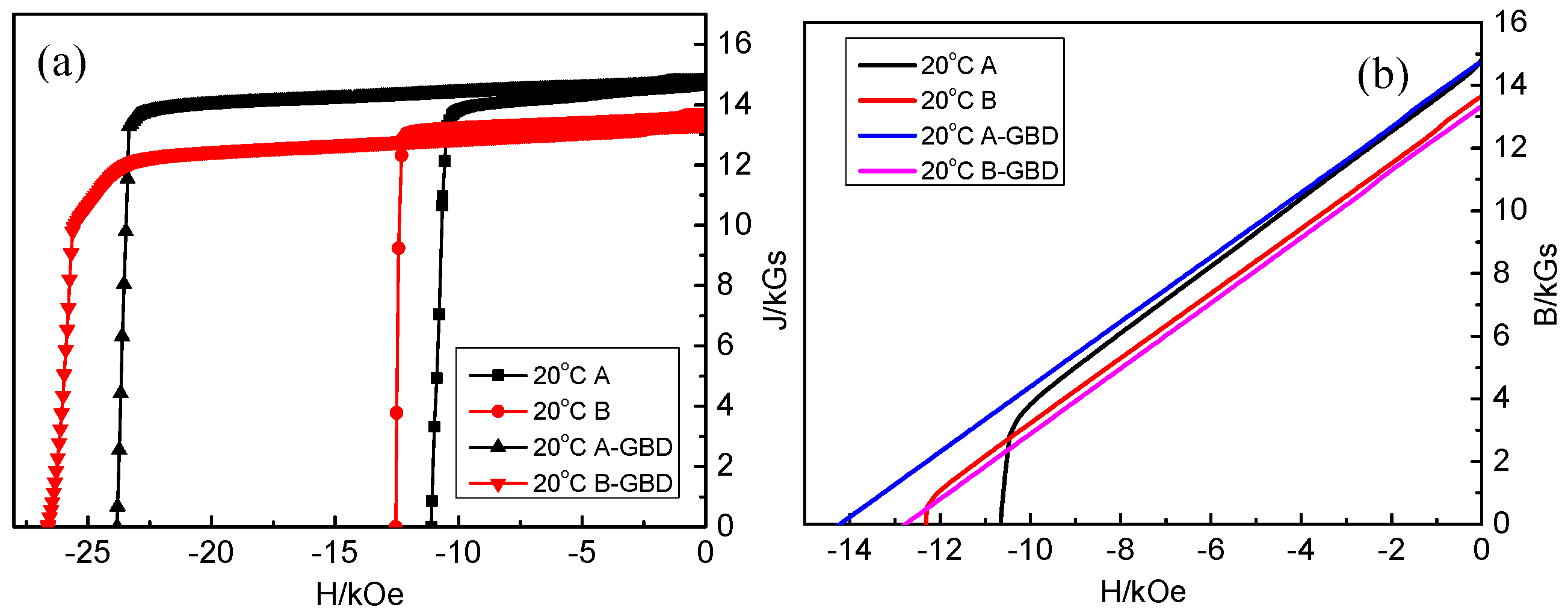
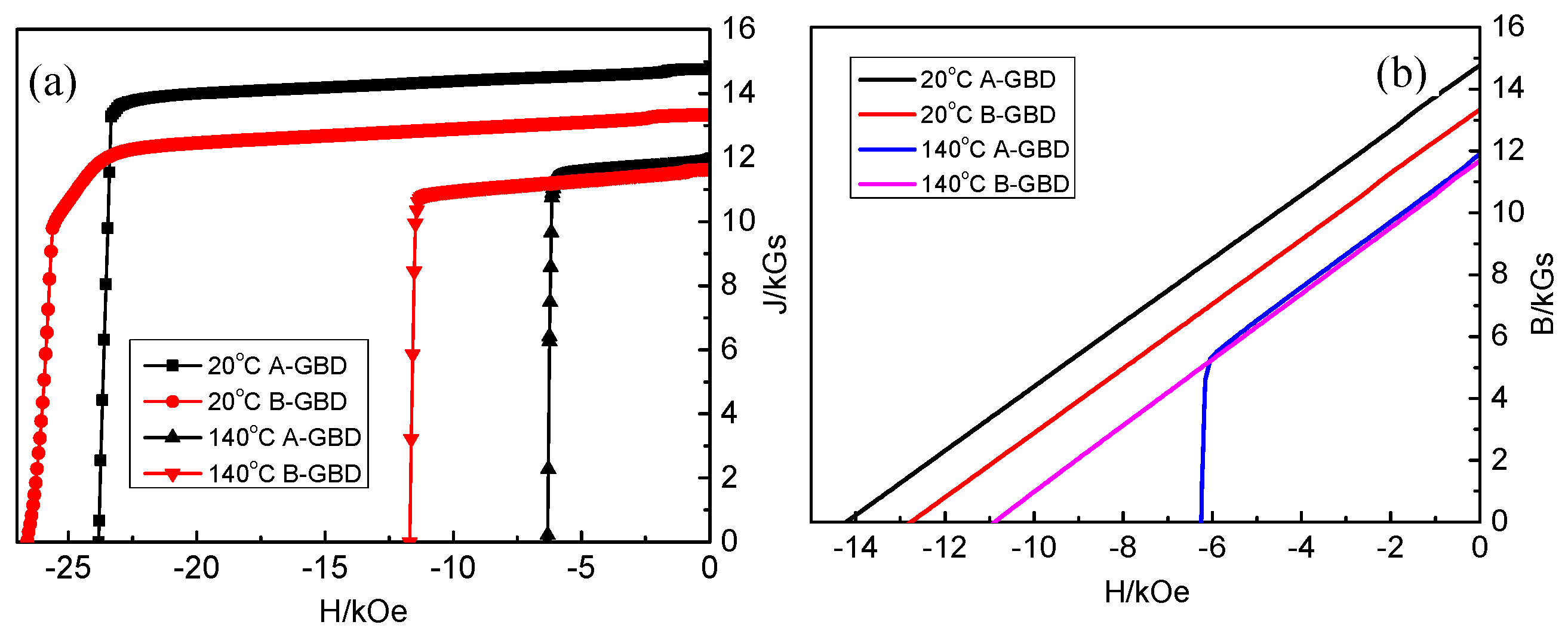
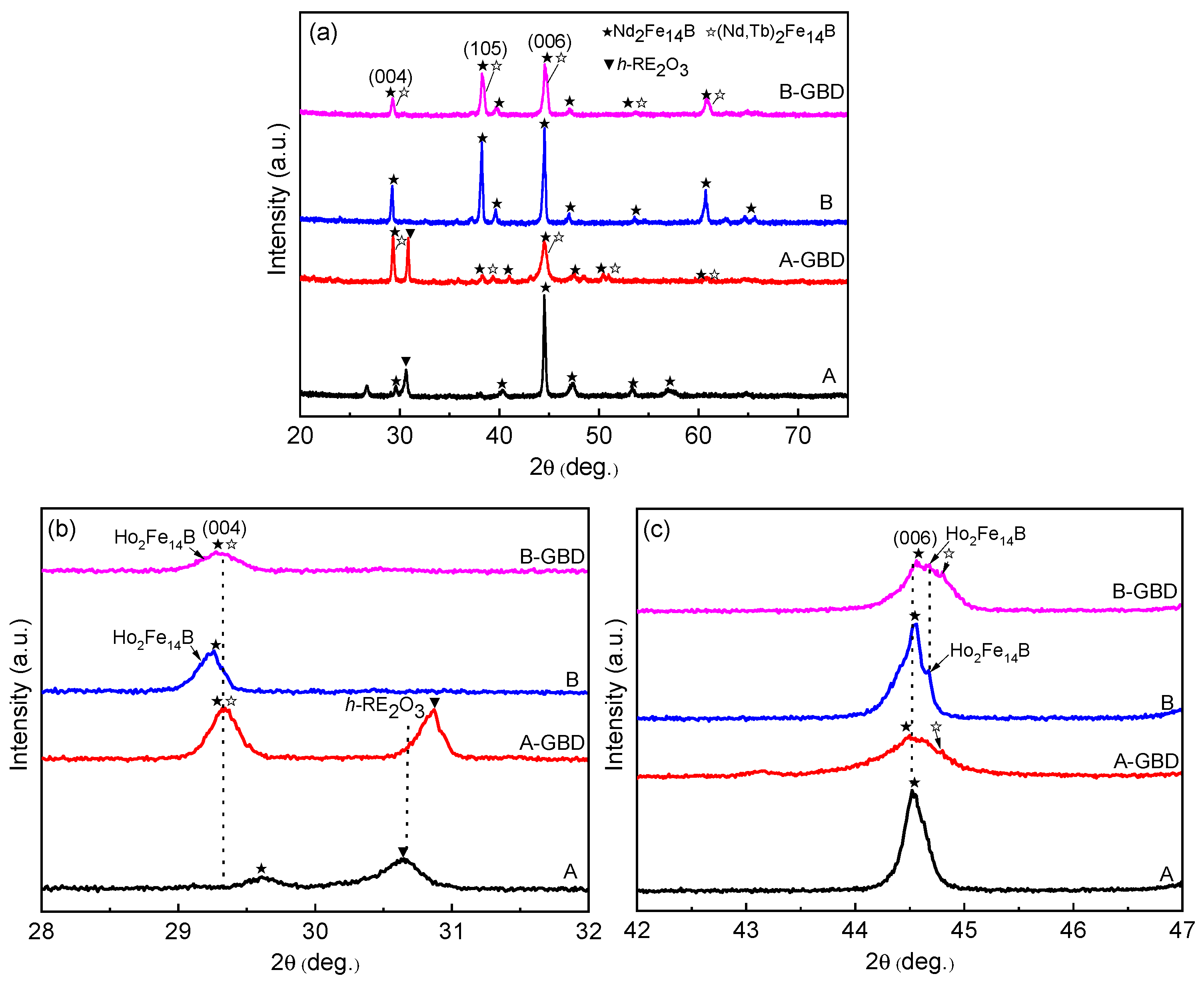

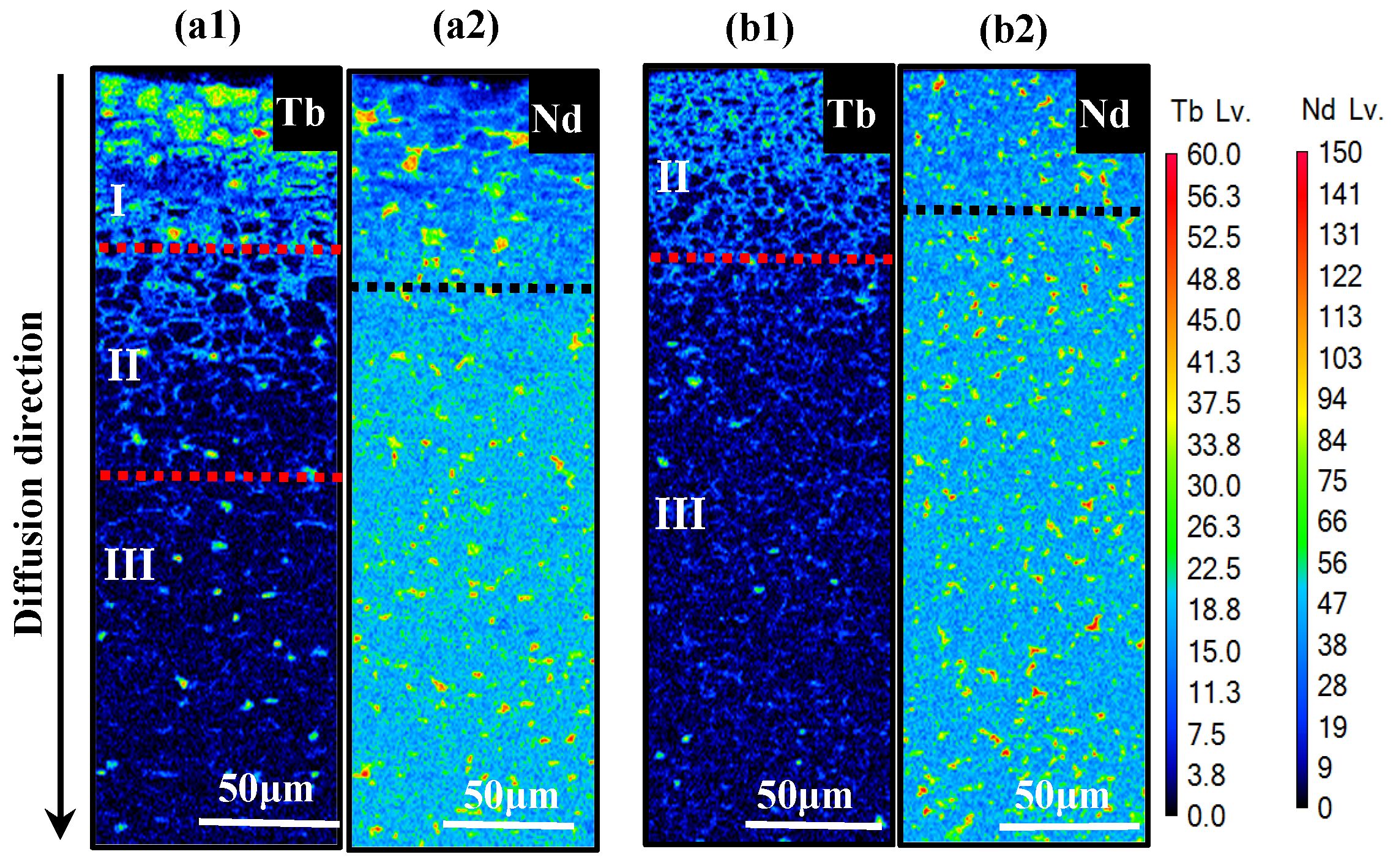
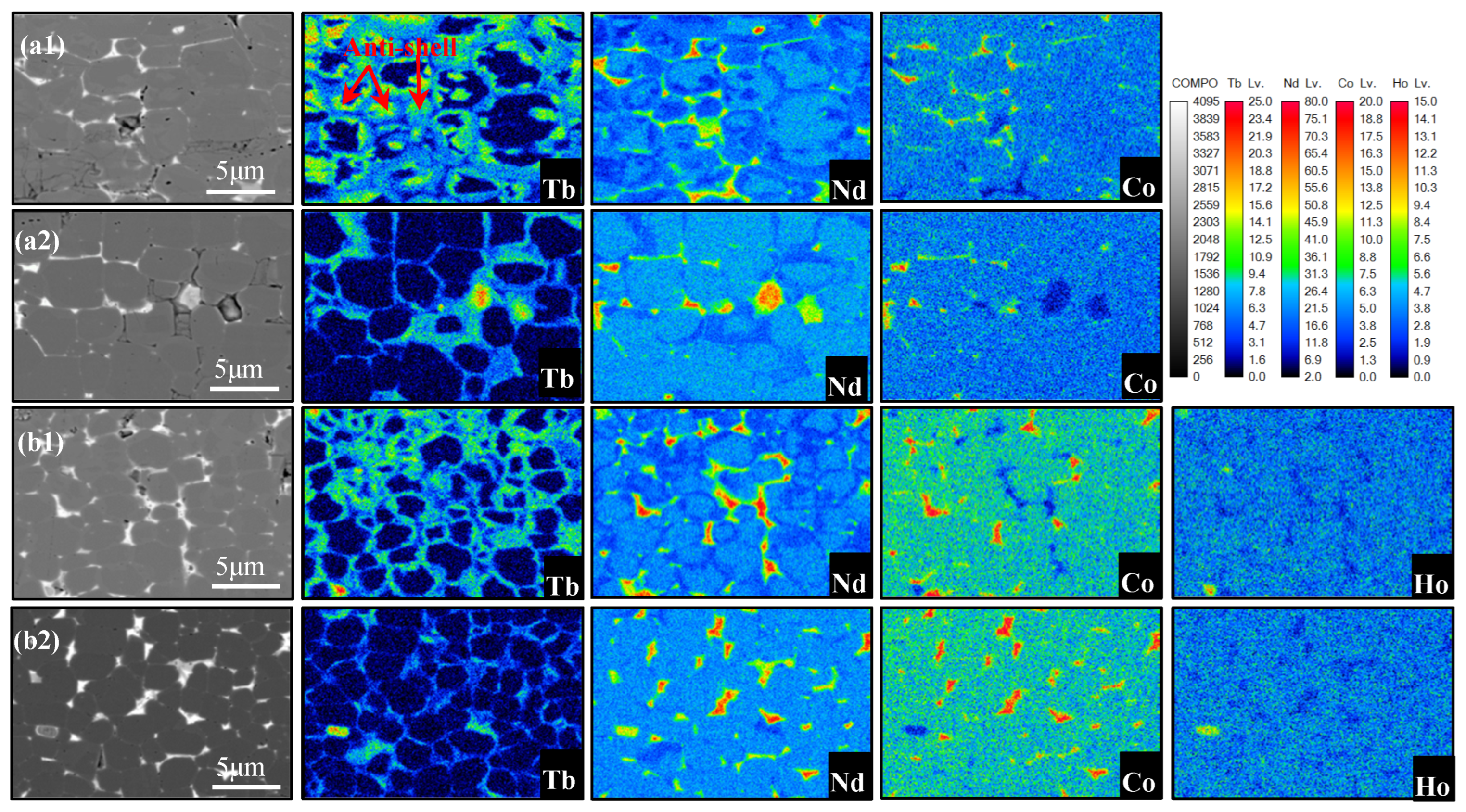
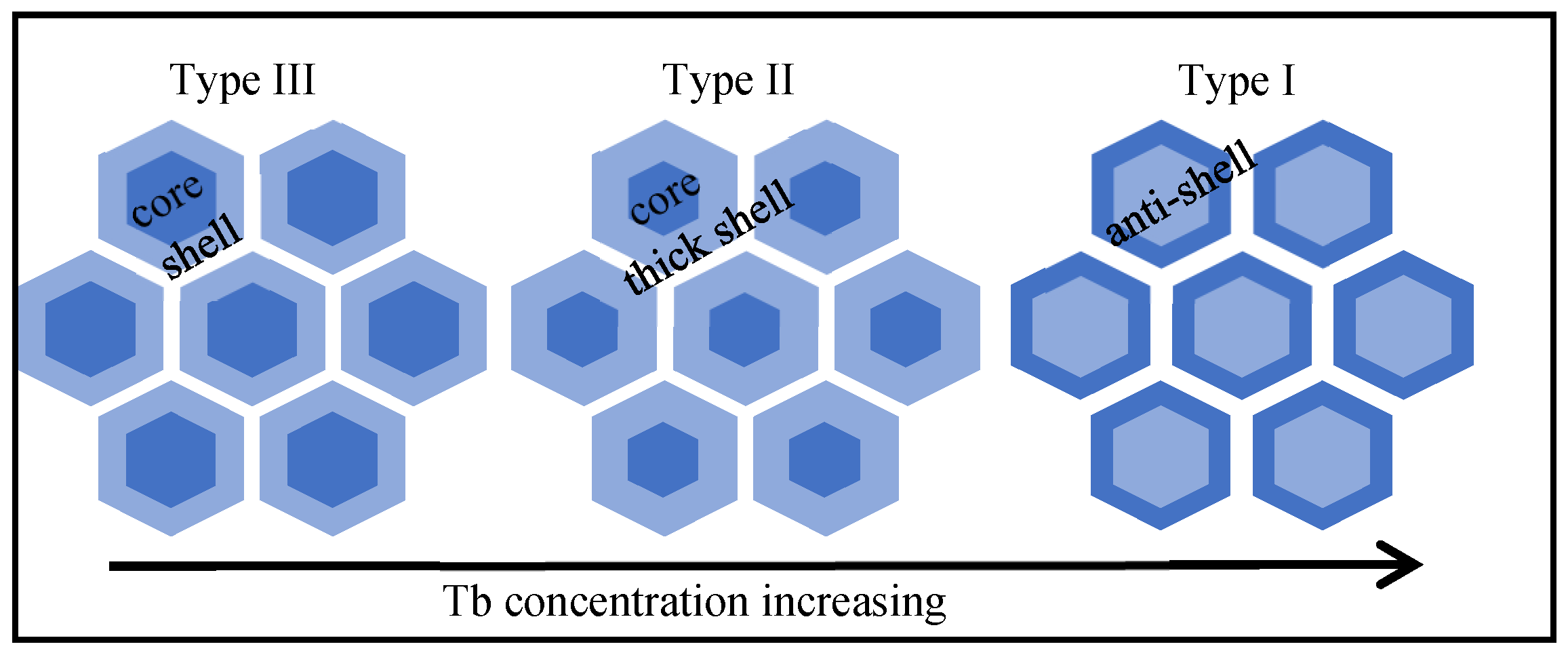
| Composition (wt.%) | Ho | Co | Nd | Fe | B | Ga | Cu |
|---|---|---|---|---|---|---|---|
| A | 0 | 1.5 | 28 | 69.2 | 1.0 | 0.1 | 0.1 |
| B | 2.5 | 2.5 | 28.5 | 65.1 | 1.0 | 0.1 | 0.1 |
| Sample | Temperature (°C) | Br (kGs) | α (%/°C) | Hcj (kOe) | β (%/°C) | (BH)max (MGOe) |
|---|---|---|---|---|---|---|
| A | 20 | 14.82 | 11.10 | 50.15 | ||
| B | 20 | 13.66 | 12.54 | 44.50 | ||
| A-GBD | 20 | 14.76 | 23.82 | 52.46 | ||
| 140 | 11.91 | −0.16 | 6.33 | −0.61 | 32.87 | |
| B-GBD | 20 | 13.34 | 26.61 | 42.47 | ||
| 140 | 11.68 | −0.10 | 11.69 | −0.47 | 31.84 |
Disclaimer/Publisher’s Note: The statements, opinions and data contained in all publications are solely those of the individual author(s) and contributor(s) and not of MDPI and/or the editor(s). MDPI and/or the editor(s) disclaim responsibility for any injury to people or property resulting from any ideas, methods, instructions or products referred to in the content. |
© 2025 by the authors. Licensee MDPI, Basel, Switzerland. This article is an open access article distributed under the terms and conditions of the Creative Commons Attribution (CC BY) license (https://creativecommons.org/licenses/by/4.0/).
Share and Cite
Zhu, X.-D.; Liu, W.-M.; Wang, F.; Xu, Z.-P.; Wang, Q.; Gu, X.-Q.; Li, M.; Jiang, Y.; Xue, F.-S.; Wang, M. The Impact of Ho Addition on the Microstructural Features and Magnetic Performances of Sintered NdFeB Magnets. Magnetochemistry 2025, 11, 32. https://doi.org/10.3390/magnetochemistry11040032
Zhu X-D, Liu W-M, Wang F, Xu Z-P, Wang Q, Gu X-Q, Li M, Jiang Y, Xue F-S, Wang M. The Impact of Ho Addition on the Microstructural Features and Magnetic Performances of Sintered NdFeB Magnets. Magnetochemistry. 2025; 11(4):32. https://doi.org/10.3390/magnetochemistry11040032
Chicago/Turabian StyleZhu, Xin-De, Wei-Ming Liu, Fei Wang, Zhao-Pu Xu, Qian Wang, Xiao-Qian Gu, Meng Li, Ya Jiang, Feng-Sheng Xue, and Mei Wang. 2025. "The Impact of Ho Addition on the Microstructural Features and Magnetic Performances of Sintered NdFeB Magnets" Magnetochemistry 11, no. 4: 32. https://doi.org/10.3390/magnetochemistry11040032
APA StyleZhu, X.-D., Liu, W.-M., Wang, F., Xu, Z.-P., Wang, Q., Gu, X.-Q., Li, M., Jiang, Y., Xue, F.-S., & Wang, M. (2025). The Impact of Ho Addition on the Microstructural Features and Magnetic Performances of Sintered NdFeB Magnets. Magnetochemistry, 11(4), 32. https://doi.org/10.3390/magnetochemistry11040032







